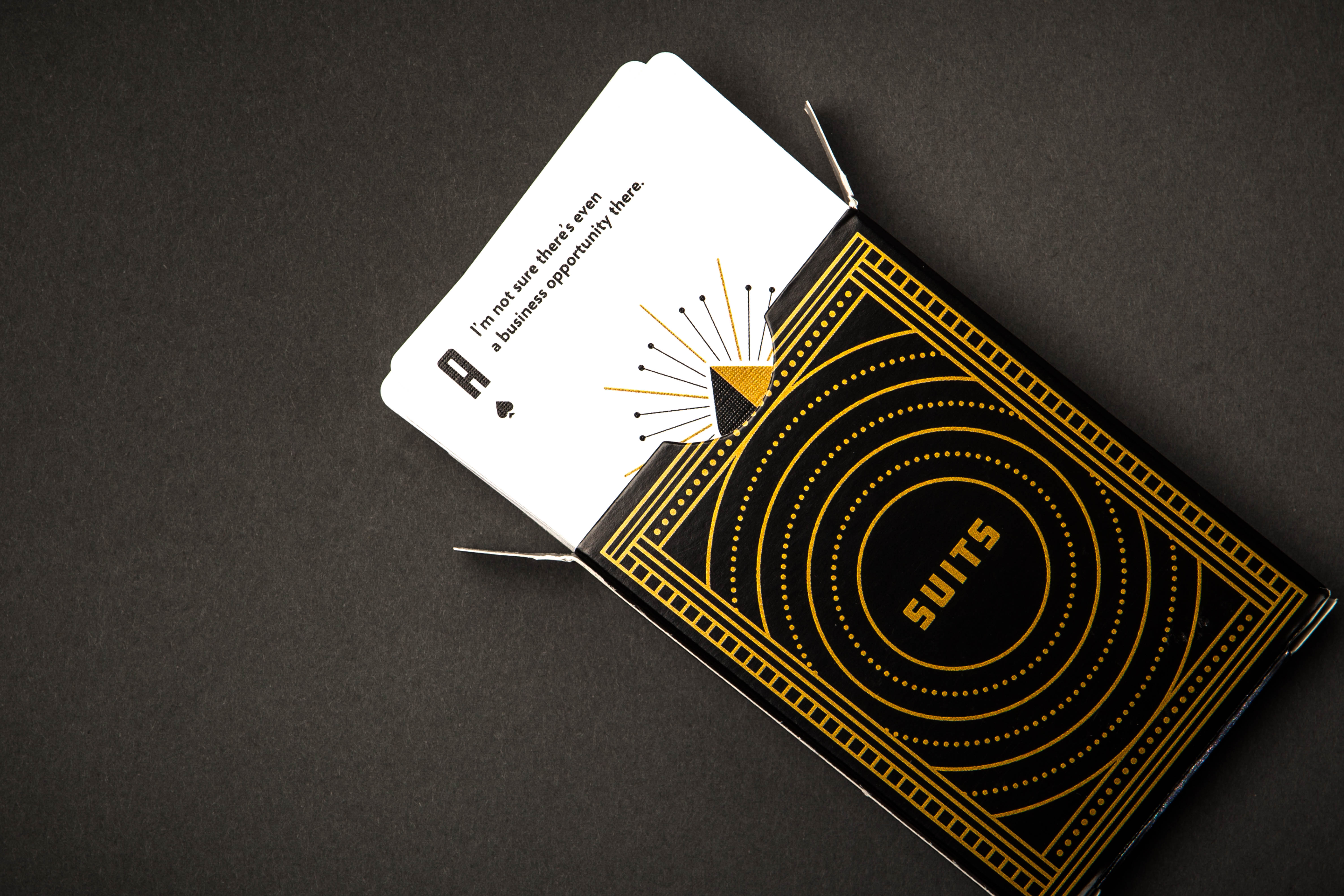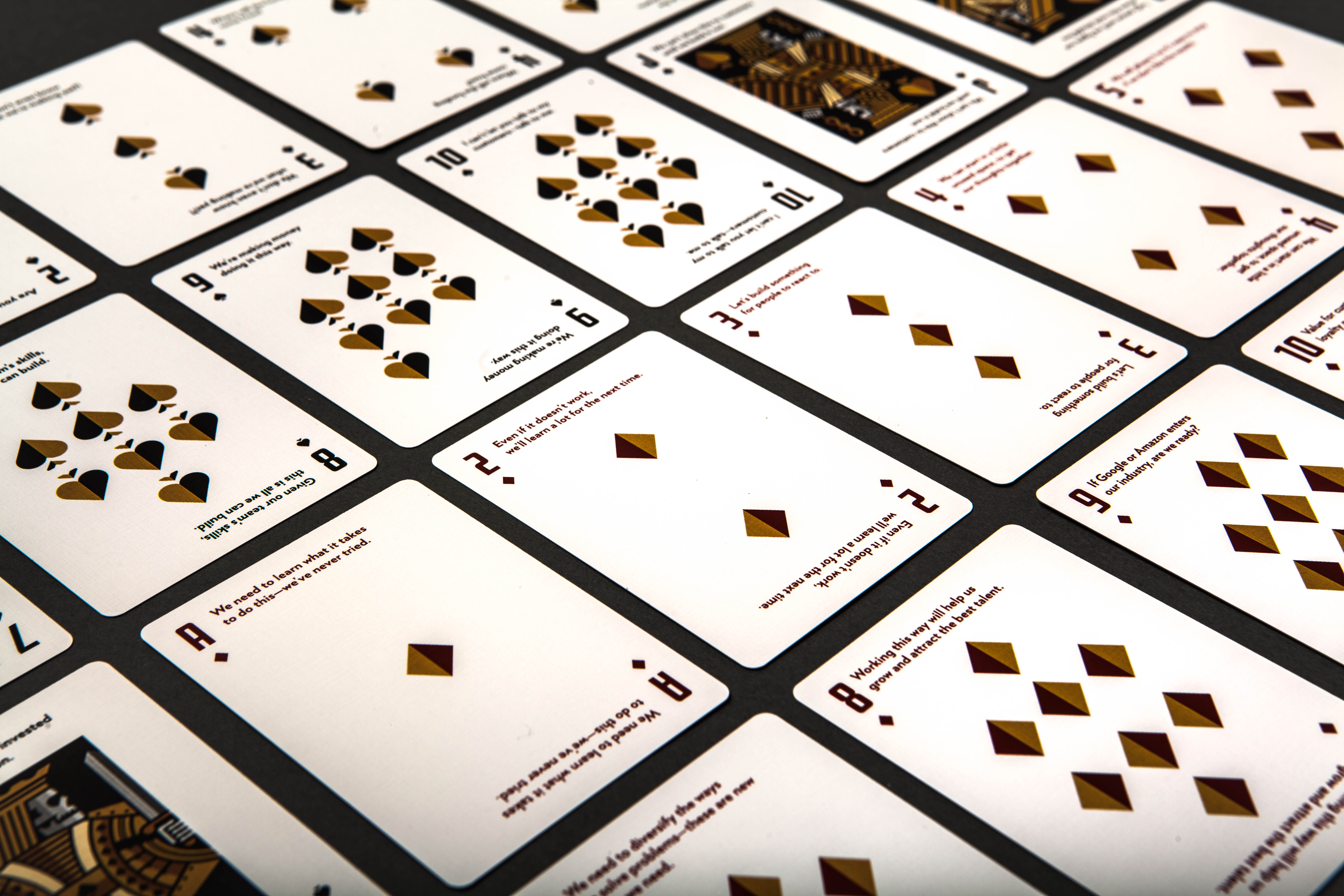26 Arguments about Innovation
Meet SUITS, the Game That Asks: “Is Innovation Just a Game to You?”
What Culture Sounds Like
You start a new job and are struck every day by the strange and unquestioned ways your new colleagues work. Even more, they seem quite unaware of their standard ways of talking and making decisions. The company seems set in its ways, cozy with the status quo. Then, within a year, you’ve assimilated and the culture has, for you too, become invisible.
Fact is, we underestimate the impact of culture on an organization’s effectiveness at innovation primarily because it is pervasive and therefore takes effort to even see and characterize. Designers are often skilled at seeing things that hide in plain sight, at “defamiliarizing” the familiar. We offer you this deck of cards, SUITS, as an example of things we have heard. Here is a collection of 52 things people say—often without thinking about it—that reflect appetite for, or discomfort with, new ways of working.
Diagnosing Your Innovation Capability
We believe that there are four traits that suggest an innovation-friendly mindset. These show up in the culture; they can be assessed and cultivated. They are:
VALUE
An organization focused on providing continued value to its customers recognizes and responds to changing environments and competitive threats in the marketplace, is results-oriented, and regards great customer experiences as their barometer of success. Strategic vision is tightly connected to CX goals in a proactive way that is open to new opportunities, anticipates disruption and is comfortable managing risk.
ENGAGEMENT
Engaged employees understand and believe in the company’s vision and strategy, are empowered to do work they feel proud of, are rewarded for their results, and have opportunity for professional growth. The company resources them to be focused and effective and reaps the benefits of high productivity and retention.
ADAPTABILITY
An adaptable organization demonstrates an effective process for quickly and effectively developing new offerings and using these offerings to execute successfully on its strategy. In navigating uncertainty, it shows openness to new ways of working, and is capable of experimenting to learn before investing in fully-scaled development.
EMPATHY
An empathetic organization is human-centered. It places the needs of both customers (external) and employees (internal) in the forefront in all aspects of its work. A customer-centric approach seeks insights from real customers, as both the foundation of strategy and as validation of solutions. Internally, empathy is demonstrated by strong mentorship and support for entrepreneurial activity.
To sum up how these four traits work together to manifest a strong culture of innovation: A future-ready organization is focused on providing value to its customers by leveraging empathy, engaged employees, and adaptable approaches to tackle uncertain and changing market conditions.
The goal of these cards is to stimulate and model workplace conversations and arguments that are true to life. They focus on an organization’s culture, and how people articulate decisions about what to do or not. Innovation is always the work done with incomplete information, yet big companies crave certainty. This game engages that tension directly.

Introducing SUITS
SUITS is a regular deck of cards that also contains 52 statements which reveal the presence or absence of these four traits. In it, the spades and clubs say “no” to innovation in 26 different ways. In companies with poor innovation capability, these are received wisdom, rarely challenged. The hearts and diamonds rebut negative arguments with statements of possibility and encouragement. As shorthand:
Clubs beat ideas down, and spades bury them. But hearts nurture ideas and diamonds make them brilliant.
We suggest you use them in any of these four ways, ideally in this order:
- As a tool for reflection. They can give you the gift of defamiliarization and let you see your company’s culture with beginner’s eyes.
- As a shared tool for self-awareness. Some clients have told us they work well as friendly “yellow cards,” or a reminder of latent bias against action.
- Played as a game, the way the instructions outline.
- In structured workshops. The cards can be used to identify which traits you need to work on cultivating, and to practice productive conversations about openness to working in new ways. To focus on individual innovation traits pull out specific cards:
For Value, the K, 9, 5 and A cards
For Engagement, the Q, 8, and 4 cards
For Adaptability, the J, 7 and 3 cards
For Empathy, the 10, 6 and 2 cards
Because the deck is an open system, we hope that you discover new ways to use them—and tell us about your ideas. Using the cards in novel ways is in itself evidence of an innovation-friendly mindset. For more information about SUITS, please send us a note.

Many thanks to Chris Caldwell for his superlative design work on SUITS.


